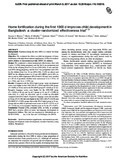| dc.contributor.author | Matias, Susana L | |
| dc.contributor.author | Mridha, Malay K | |
| dc.contributor.author | Tofail, Fahmida | |
| dc.contributor.author | Arnold, Charles D | |
| dc.contributor.author | Khan, Md Showkat A | |
| dc.contributor.author | Siddiqui, Zakia | |
| dc.contributor.author | Ullah, Md Barkat | |
| dc.contributor.author | Dewey, Kathryn G | |
| dc.date.accessioned | 2018-01-04T09:52:54Z | |
| dc.date.available | 2018-01-04T09:52:54Z | |
| dc.date.issued | 2017-03-08 | |
| dc.identifier.citation | Matias, S. L., Mridha, M. K., Tofail, F., Arnold, C. D., Khan, M. S. A., Siddiqui, Z., … Dewey, K. G. (2017). Home fortification during the first 1000 d improves child development in Bangladesh: A cluster-randomized effectiveness trial. American Journal of Clinical Nutrition, 105(4), 958–969. https://doi.org/10.3945/ajcn.116.150318 | en_US |
| dc.identifier.issn | 00029165 | |
| dc.identifier.uri | http://hdl.handle.net/10361/8918 | |
| dc.description | This article was published in the American Journal of Clinical Nutrition [© 2017 American Journal of Clinical Nutrition ] and the definite version is available at : https://doi.org/10.1371/journal.pone.0169109 . The Journal's website is at:http://ajcn.nutrition.org/content/early/2017/03/08/ajcn.116.150318.full.pdf+html | en_US |
| dc.description.abstract | Background: Nutrition during the first 1000 d is critical for brain development.Objective: We evaluated the effects on child development of home fortification with lipid-based nutrient supplements (LNSs) for mothers and/or children or micronutrient powder (MNP) for children.Design: We conducted a cluster-randomized effectiveness trial with 4 arms: 1) LNSs during pregnancy and the first 6 mo postpartum and LNSs for the offspring from 6 to 24 mo (LNS-LNS), 2) iron and folic acid (IFA) during pregnancy and the first 3 mo postpartum and LNSs for the children from 6 to 24 mo (IFA-LNS), 3) IFA (as above) and MNP for the offspring from 6 to 24 mo (IFA-MNP), and 4) IFA (as above) and no child supplement (IFA-Control). Women were enrolled at ≤20 wk of gestation; children were assessed at 12 (n = 3331), 18 (n = 3364), and 24 (n = 3379) mo.Results: Compared with the IFA-Control group, motor development scores were higher in the LNS-LNS (P = 0.016) and IFA-LNS groups (P = 0.006) at 18 mo and in the IFA-MNP group (P = 0.048) at 24 mo. Receptive language scores were higher for the LNS-LNS group (P = 0.028) at 18 mo and for all 3 groups at 24 mo (P = 0.008 for LNS-LNS, P = 0.022 for IFA-LNS, and P = 0.009 for IFA-MNP compared with IFA-Control). Expressive language scores did not differ at 18 mo (P = 0.236) but were higher in the LNS-LNS (P = 0.035) and IFA-MNP (P = 0.002) groups than in the IFA-Control group at 24 mo. Groups did not differ in personal-social scores at 18 (P = 0.233) or 24 (P = 0.146) mo or in executive function score at 24 mo (P = 0.467).Conclusion: Prenatal LNSs, postnatal LNSs, or both, or postnatal MNP had a positive effect on motor and language development in Bangladeshi children. This trial was registered at clinicaltrials.gov as NCT01715038. | en_US |
| dc.language.iso | en | en_US |
| dc.publisher | © 2017 American Journal of Clinical Nutrition | en_US |
| dc.relation.uri | http://ajcn.nutrition.org/content/early/2017/03/08/ajcn.116.150318.full.pdf+html | |
| dc.subject | Bangladesh | en_US |
| dc.subject | Executive function | en_US |
| dc.subject | Language development | en_US |
| dc.subject | Lipid-based nutrient supplements | en_US |
| dc.subject | Micronutrient powder | en_US |
| dc.subject | Motor development | en_US |
| dc.subject | Young children | en_US |
| dc.title | Home fortification during the first 1000 d improves child development in Bangladesh: a cluster-randomized effectiveness trial | en_US |
| dc.type | Article | en_US |
| dc.description.version | Published | |
| dc.identifier.doi | https://doi.org/10.3945/ajcn.116.150318 | |

